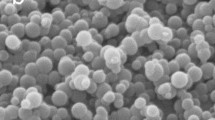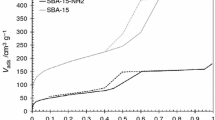Abstract
Adsorption modification of nanosilica allows effective regulation of its physicochemical, structural–mechanical, pharmacological, and biological properties thus broadening its field of application. Liquid-phase methods used for this purpose have several substantial drawbacks mainly of a technological and ecological character. Therefore a new effective and ecologically safe method was developed for adsorption modification of nanosilica with non-volatile organic compounds (bioactive compounds, polymers). The process is carried out in fluidized state in gaseous dispersion medium with the solvent atmosphere. The developed method allows one to achieve a defined degree of surface coverage and to conserve initial dispersity of silica required.
Access this chapter
Tax calculation will be finalised at checkout
Purchases are for personal use only
Similar content being viewed by others
References
Mironyuk I F, Voronin E F, Pakhlov E M et al (2000) Effect of manufacture conditions on hydrophilicity of high-disperse fumed silica. Ukr Chem J 66:81–83
Gun’ko V M, Mironyuk I F, Voronin E F et al (2001) Controlled effect on structure of high-disperse silicas. Phys Chem Solids 2:57–64
Sobolev V A, Khoma M I, Ogenko V M et al (1975) Study of the effect of vapour-phase conditions of high-disperse silica synthesis on its structural characteristics. Adsorption Adsorbents 3:79–83
Kiselev A V (1986) Intermolecular interactions in adsorption and chromatography. Visshaja shkola, Moscow
Iler R K (1978) The chemistry of silica: solubility, polymerization, colloid and surface properties and biochemistry of silica. Wiley-Interscience, New York
Legrand A P (ed) (1998) The surface properties of silicas. Wiley, New York
Lisichkin G V (2003) The chemistry of surface-drafted compounds. Physmathlit, Moscow
Chuiko A A (ed) (2001) The chemistry of silica surface. UkrINTEI, Kyiv
Chuiko A A (ed) (2003) The medical chemistry and clinical application of silica. Naukova dumka, Kiev
British Pharmacopoeia (2008) http://www.pharmacopoeia.co.uk/
Kiselev A V, Lygin V I (1972) Infrared spectra of surface compounds. Nauka, Moscow
Hair M L (1967) Infrared spectroscopy in surface chemistry. Marcel Dekker, New York
Zhdanov S P (1987) IR study of hydroxylated silica. Langmuir 3:960–967
Guzenko N V, Pakhlov E M, Lipkovskaya N A et al (2001) Sorption modification of fine silica with polyvinylpyrrolidone. Russ J Appl Chem 74:2017–2020
Parfit G D, Rochester C H (eds) (1983) Adsorption from solution at the solid/liquid interface. Academic Press, London
Guzenko N V, Voronina O E, Vlasova N N et al (2004) UV spectral study of iodine, polyvinylpyrrolidone and protein in solution and on silica surface. J Appl Spectrosc 71:141–144
Nosach L V, Voronin E F (2006) Adsorption modification of high-disperse silica with non-volatile organic compounds under conditions of gaseous dispersion medium. Phys Chem Solids 3:540–543
Davidenko N K, Shevchenko N M, Bogomaz V I et al (1992) Ethonium adsorption on high-disperse silica surface. J Phys Chem 66:2778–2780
Goncharik V P, Kaspersky V O, Kozhara L I et al (2000) Decamethoxine adsorption on high-disperse silica. Pharm J 5:55–58
Slyshik N F, Nosach L V, Voronin E F (2004) Adsorption of tetracycline antibiotics on high-disperse silica surface. Chem Phys Technol Surf 10:170–174
Kulik T V, Palyanytsya B B, Galagan N P (2003) Molecular self-assembly in systems of nanosized particles and hydrocarbons. Nanosyst Nanomater Nanotechnol 2:681–690
Nastasienko N S, Mischanchuk B G, Galagan N P (2004) Mass-spectroscopic study of sorbitol and xylitol thermolysis. Chem Phys Technol Surf 10:198–201
Author information
Authors and Affiliations
Corresponding author
Editor information
Editors and Affiliations
Rights and permissions
Copyright information
© 2009 Springer Science+Business Media B.V.
About this chapter
Cite this chapter
Voronin, E., Nosach, L., Guzenko, N., Pakhlov, E., Gabchak, O. (2009). Adsorption Modification of Nanosilica with Non-volatile Organic Compounds in Fluidized State. In: Shpak, A., Gorbyk, P. (eds) Nanomaterials and Supramolecular Structures. Springer, Dordrecht. https://doi.org/10.1007/978-90-481-2309-4_13
Download citation
DOI: https://doi.org/10.1007/978-90-481-2309-4_13
Published:
Publisher Name: Springer, Dordrecht
Print ISBN: 978-90-481-2308-7
Online ISBN: 978-90-481-2309-4
eBook Packages: Chemistry and Materials ScienceChemistry and Material Science (R0)




